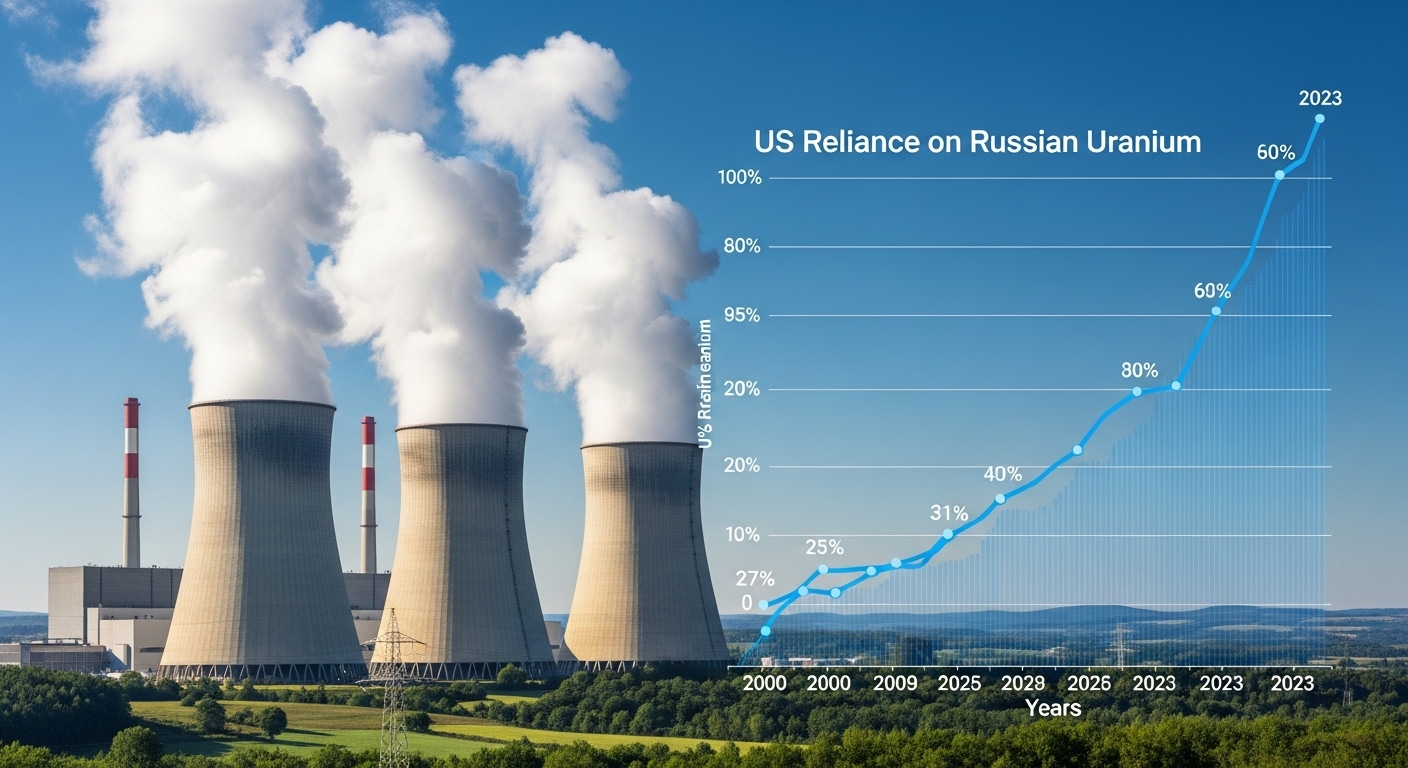Nuclear power stands as a cornerstone of the United States’ energy security and ambitious clean energy goals, providing a significant portion of the nation’s carbon-free electricity. It’s a reliable, always-on energy source that complements renewables and ensures grid stability. However, beneath this vital contribution lies a complex and often overlooked challenge: the nation’s surprising dependency on foreign sources for its nuclear fuel. This quiet vulnerability has become a pressing concern, particularly in a world grappling with shifting geopolitical landscapes.
Introduction: Unpacking the US’s Nuclear Fuel Dilemma
The Silent Energy Crisis
Nuclear power stands as a cornerstone of the United States’ energy security and ambitious clean energy goals, providing a significant portion of the nation’s carbon-free electricity. It’s a reliable, always-on energy source that complements renewables and ensures grid stability. However, beneath this vital contribution lies a complex and often overlooked challenge: the nation’s surprising dependency on foreign sources for its nuclear fuel. This quiet vulnerability has become a pressing concern, particularly in a world grappling with shifting geopolitical landscapes.
The Core Issue: US Reliance on Russian Uranium
Despite escalating tensions and a concerted effort to decouple from Russian energy, the United States finds itself in a precarious position due to its significant US reliance on Russian uranium. This dependency isn’t just a matter of economics; it’s a critical national security issue, highlighting a paradox where a nation striving for energy independence relies on a geopolitical rival for a fundamental component of its power infrastructure. The implications stretch across economic, political, and strategic domains, demanding urgent attention and decisive action.
What This Article Will Cover
This article will delve deep into the intricate web of US reliance on Russian uranium. We’ll explore the current extent of this dependency, tracing its historical roots back to post-Cold War policies. We’ll then examine the economic and technical factors that have perpetuated this reliance, alongside the significant risks it poses to national security and energy stability. Finally, we’ll outline the comprehensive strategies and solutions the US is implementing to forge a path toward a resilient and independent nuclear future.
The Extent of US Reliance on Russian Uranium
Current Dependency Figures
The numbers paint a clear picture of significant reliance. As of 2022, the US acquired approximately 24% of its crucial enrichment services from Russia. This figure climbed in 2023, with Russia supplying a notable 27% of enriched uranium to American reactors. Looking at broader imports, Russia accounted for roughly 35% of US imports for nuclear fuel in May 2024, solidifying its position as the largest foreign supplier of enriched uranium to the US in both 2022 and 2023 [1]. These statistics underscore a deep integration of Russian supply into the American nuclear power infrastructure, highlighting the profound US reliance on Russian uranium.

The Nuclear Fuel Cycle Explained
To fully grasp the nature of this dependency, it’s essential to understand the nuclear fuel cycle. It begins with mining and milling, where uranium ore is extracted and processed into “yellowcake.” This yellowcake then undergoes conversion into uranium hexafluoride gas. The next, and often most complex, stage is enrichment, where the concentration of the fissile isotope U-235 is increased. Finally, the enriched uranium is used for fuel fabrication, creating the fuel rods that power reactors. The US currently faces significant domestic capacity gaps, particularly in the critical enrichment and conversion stages, which largely explain the need for foreign suppliers like Russia.
Financial Implications of Reliance
The financial cost of this dependency is substantial. In 2022, US companies paid over $850 million to Russia for nuclear fuel services. This figure escalated further in 2023, with American utilities spending $1.2 billion on enriched uranium from Russia [1]. These payments not only support a rival nation’s economy but also highlight the considerable economic leverage Russia holds over a vital sector of US infrastructure.
Historical Roots: How the US Became Dependent
Post-Cold War Dynamics and the “Megatons to Megawatts” Program
The roots of current US reliance on Russian uranium stretch back to the optimistic post-Cold War era. In the 1990s, the “Megatons to Megawatts” program saw the US purchase large quantities of down-blended, weapons-grade uranium from the former Soviet Union. This initiative, while laudable for non-proliferation, inadvertently led the US to turn away from investing in its own domestic enrichment capabilities, as a cheap and abundant supply seemed readily available from abroad. It was a strategic shift that, in hindsight, created a long-term vulnerability.
Decline of Domestic Production and Enrichment
Following the “Megatons to Megawatts” program, US domestic uranium production plummeted, and several enrichment facilities either closed or saw their operations scaled back significantly. The US, once a leader in nuclear fuel production, shifted towards relying heavily on foreign imports. This decline coincided with Russia’s strategic expansion in the global nuclear fuel market, particularly in enrichment capacity, where it now commands an estimated 44% share globally [2]. This imbalance left the US in a vulnerable position, increasingly dependent on external sources for a crucial energy component.

The “Need” for Russian Uranium: Economic and Technical Factors
Cost-Effectiveness and Market Forces
For decades, Russia has been a highly cost-effective producer of enriched uranium, offering competitive prices that made it an attractive option for US utilities looking to keep electricity generation costs down. This economic advantage, driven by state-backed enterprises like Rosatom, allowed Russia to capture a significant market share, making it difficult for US power companies to justify sourcing from higher-cost domestic or allied alternatives when they existed.
Lack of US Enrichment Capacity
A critical factor contributing to US reliance on Russian uranium is the severe lack of domestic enrichment capacity. The US currently operates only one commercial enrichment plant, Urenco USA, which is a consortium primarily owned by British, Dutch, and German interests. This single facility supplies approximately one-third of the country’s enriched uranium needs, leaving a substantial gap that foreign suppliers must fill. Furthermore, the US lacks any US-owned conversion facilities, adding another layer of dependency in the nuclear fuel supply chain.
Specialized Fuels: The HALEU Challenge
The challenge extends to specialized fuels. Russia stands as the only commercial supplier of high-assay low-enriched uranium (HALEU), a critical component for the next generation of advanced nuclear reactors currently under development in the US and globally. Without a domestic HALEU supply, the ambitious plans for these innovative reactors, which promise enhanced safety and efficiency, face significant delays and continued reliance on Russia, underscoring a key vulnerability in the US’s future nuclear energy strategy.

Risks and Vulnerabilities of Continued US Reliance on Russian Uranium
National Security and Geopolitical Leverage
The continued US reliance on Russian uranium poses a direct national security threat. It grants Russia significant geopolitical leverage, allowing it to potentially “weaponize” energy dependence, much as it has done with natural gas supplies to Europe. Rosatom, Russia’s state nuclear energy corporation, is deeply intertwined with the Russian government and its nuclear weapons program, and its revenues indirectly fund military activities. This creates a moral and strategic dilemma for the US, funding a rival while simultaneously striving for its own security.
Supply Chain Disruptions and Market Volatility
The risks of supply chain disruptions are palpable. Russia has already demonstrated its willingness to use energy as a political tool, as evidenced by its retaliatory export ban on uranium in November 2024, albeit with a waiver provision. Such actions can lead to sudden cut-offs or restrictions, causing significant market volatility and potential price spikes for uranium enrichment services, ultimately impacting electricity costs for American consumers. A diversified and secure nuclear fuel supply chain is paramount to mitigate these risks.
Impact on US Nuclear Energy Expansion
Dependency on external, potentially hostile, sources can severely hinder the growth of US nuclear power. Nuclear energy is a vital component of the nation’s clean energy goals and is increasingly seen as essential for meeting the burgeoning electricity demand from new sectors like AI data centers. Without a secure and reliable domestic uranium enrichment and supply chain, the expansion of nuclear power in the US, crucial for both environmental and economic reasons, could be significantly constrained, jeopardizing long-term energy stability.
Pathways to Independence: US Strategies and Solutions
Recent Legislative Action: The Russian Uranium Ban
A significant step towards breaking this dependency was taken in May 2024, when President Biden signed the “Prohibiting Russian Uranium Imports Act.” This landmark legislation bans the import of Russian enriched uranium, effective August 12, 2024. Crucially, it includes a temporary waiver process, allowing for limited imports until January 2028, providing a crucial transition period for US utilities to secure alternative supplies and for domestic production to ramp up [3]. This act signals a clear commitment to reducing US reliance on Russian uranium.
Investing in Domestic Uranium Production and Enrichment
To rebuild its capabilities, the US government has allocated substantial resources. A total of $2.72 billion in federal funds has been earmarked to revitalize the US nuclear fuel supply chain, specifically targeting the expansion of both low-enriched uranium (LEU) and HALEU production [4]. The Department of Energy (DOE) is leading initiatives, including the Defense Production Act Consortium, to accelerate domestic capacity across mining, milling, conversion, and enrichment. These efforts are already showing results, with US domestic uranium production reaching a six-year high in 2024, indicating a promising resurgence in the sector and a step towards true energy independence US.

Diversifying International Uranium Suppliers
While boosting domestic capacity, the US is also actively diversifying its international uranium suppliers. Key allied countries such as Canada, Kazakhstan, Australia, and Uzbekistan are major sources of uranium and are being engaged to secure reliable supply chains. Furthermore, international collaborations, like the Sapporo 5 group (comprising Canada, Japan, France, the UK, and the US), are working together to bolster global nuclear fuel supply chain resilience and reduce overall reliance on any single nation, especially Russia.
Advancing Nuclear Technologies
The push for domestic uranium enrichment also extends to advanced nuclear technologies. The development of domestic HALEU production capabilities is not just about replacing Russian supply; it’s about enabling the deployment of advanced reactor designs that promise greater efficiency, safety, and waste reduction. By leading in HALEU production, the US has an opportunity to re-establish itself as a global leader in nuclear innovation and secure its long-term nuclear future, fostering true energy independence US.
The Future of US Nuclear Energy Without Russian Uranium
Challenges and Opportunities Ahead
Achieving full independence from US reliance on Russian uranium by the 2028 waiver deadline presents a significant, but not insurmountable, challenge. It requires sustained investment, rapid scaling of new technologies, and close collaboration between government and industry. However, this challenge also brings immense opportunity: the chance for the US to regain its leadership position in the global nuclear fuel market, create high-tech jobs, and ensure a secure energy future. The transition will be complex, but the long-term benefits of a robust, domestic nuclear fuel supply chain are undeniable.

Impact on Energy Security and Climate Goals
Ultimately, a secure and domestic nuclear fuel supply chain is not merely an economic or political objective; it is critical for national energy security and for achieving ambitious carbon-free electricity targets. By reducing US reliance on Russian uranium, the nation strengthens its resilience against geopolitical shocks, ensures the stable operation of its nuclear fleet, and reinforces its commitment to a cleaner energy future. This strategic pivot will safeguard both the lights and the planet for generations to come.
Conclusion: Towards a Resilient and Independent Nuclear Future
The journey to disentangle the US reliance on Russian uranium is a complex but essential undertaking. From historical policy choices to current geopolitical realities, the path to independence requires a multi-faceted approach involving legislative action, significant domestic investment, and strategic international partnerships. While challenges remain, the concerted efforts to rebuild the US nuclear fuel supply chain and foster domestic uranium enrichment promise a future where American nuclear power is not only clean and reliable but also truly secure and independent. This strategic shift is vital for national security, economic stability, and the pursuit of a sustainable energy future, ultimately ending the deep US reliance on Russian uranium.



